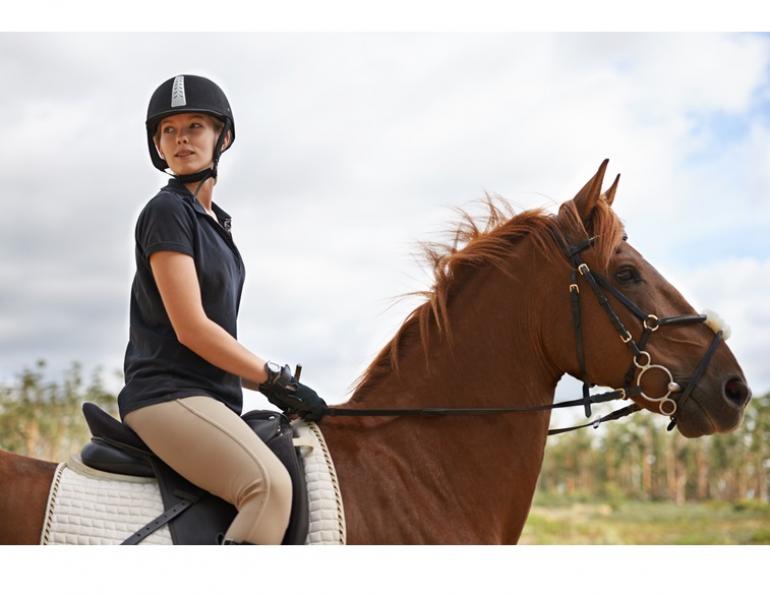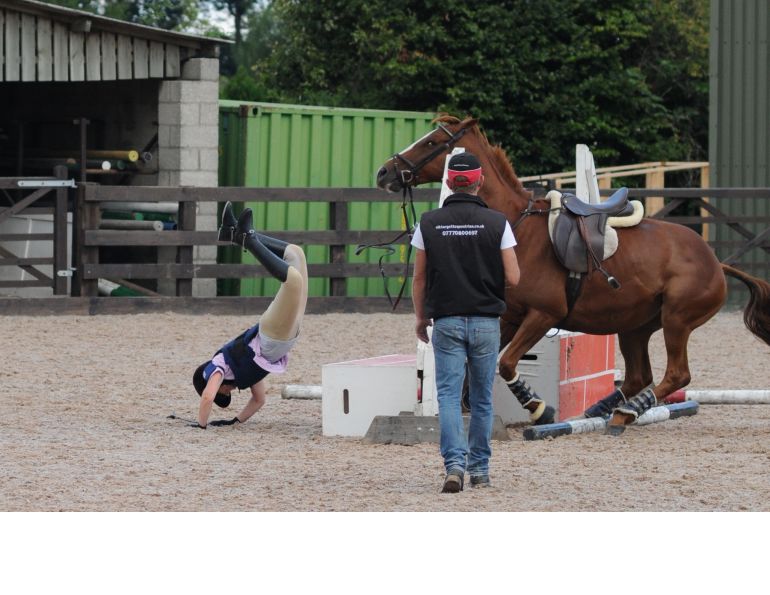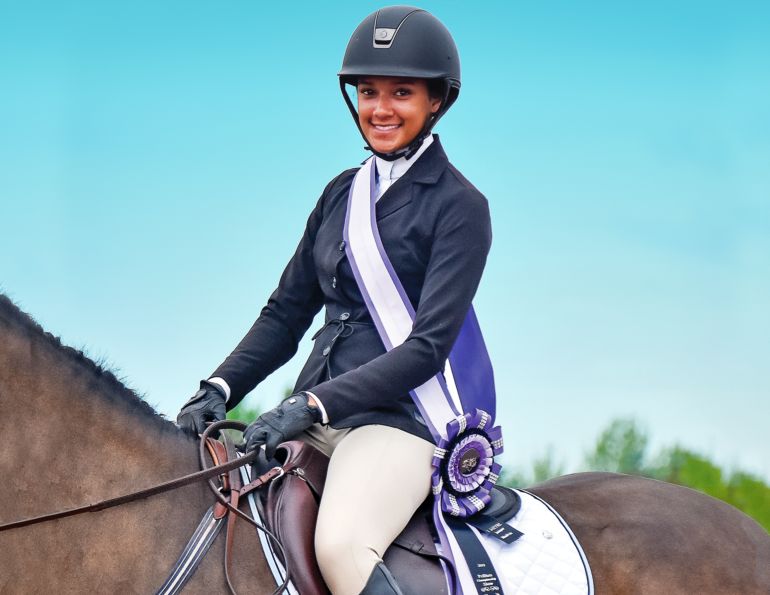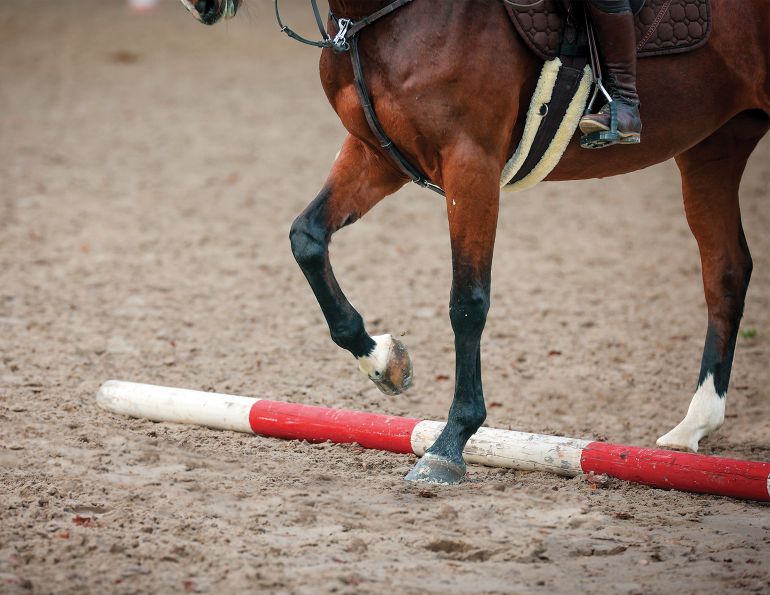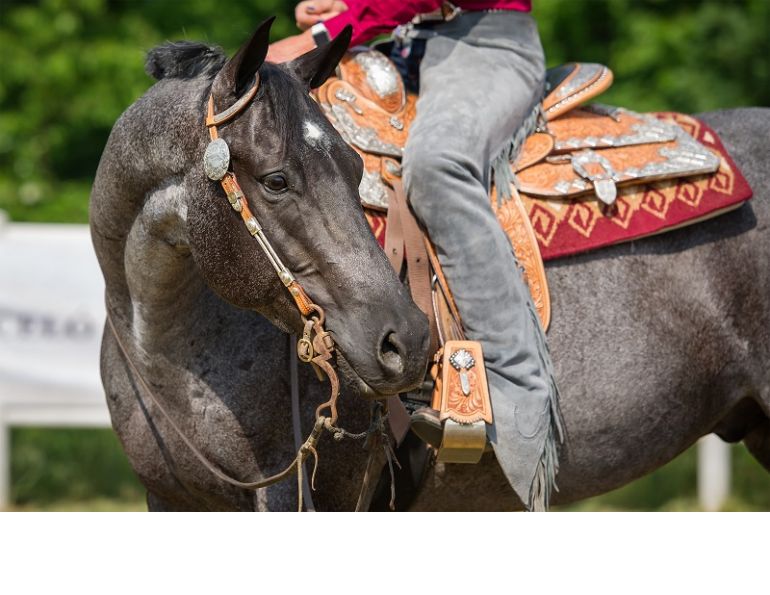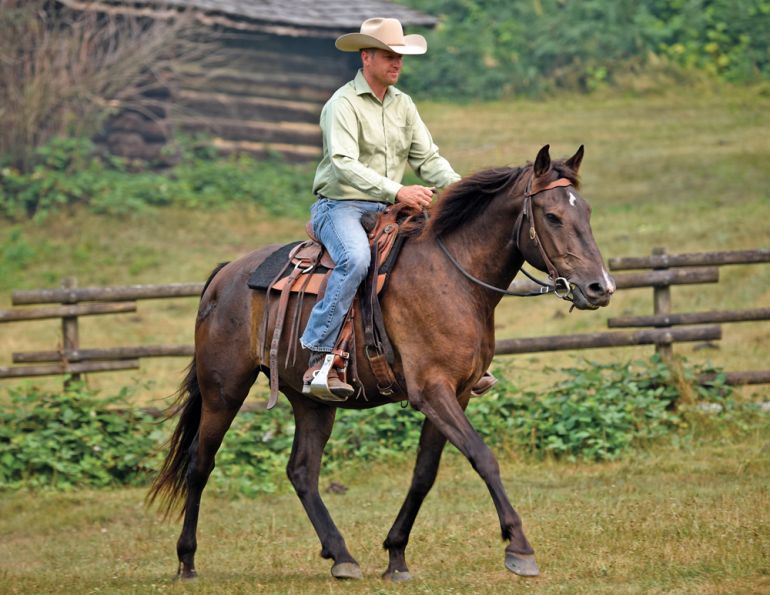By Margaret Evans
In the summer of 1381, Anne of Bohemia, only 15 years old, left her home at Hradschin Palace in Prague in the Kingdom of Bohemia (modern day Czech Republic). Ahead of her lay a 1,100-kilometre trip on horseback across Europe to Calais, France, where she and her entourage would take a boat across the English Channel to England, to her arranged marriage to Richard II, the King of England, also 15 years old, whom she had never met.
Anne would ride a palfrey, a small, well-bred, highly prized horse of the Middle Ages. With smooth, ambling gaits ideal for long distance riding, the palfrey was popular with nobles, ladies, and highly ranked knights. To maintain her modesty and dignity, Anne rode aside in a unique saddle that looked more like a chair. She sat sideways with her feet on a small footrest, or “planchette,” and had a rail to hold to steady herself.
But the design of the saddle and her position in relation to the forward movement of the horse would not allow her to control him with the reins. She sat at a right angle to the horse’s head. Likely, the sidesaddle itself was insecure. As a result, Anne’s horse was led by a male rider.
Women, of course, had been riding for centuries, mostly astride and sometimes aside. The concept of keeping both legs on the same side of the horse was depicted on Greek vases and Celtic stones. Some images showed the woman seated aside and being led by a man, while others depicted her seated on a small padded seat called a pillion behind a male rider. But at all times aside, the woman was a passenger along for the ride.
Culture and modesty dictated the aside approach. For an aristocratic woman, it was considered unbecoming to straddle a horse with legs apart. And keeping both legs together by riding aside was believed to protect the hymen, and thus the presumed resemblance of being a virgin.
Women wore long skirts when riding, but skirts were impractical, immodest, and downright dangerous should the rider get tangled up with a horse in a fall. Many women were dragged to their death. Riding aside, while keeping the skirt a bit more under control, still had its shortcomings, especially during the era when women had no control of the horse and had to be led. Saddle makers, they decided, had to up their game and design a saddle that allowed the rider to control both her horse and her modesty.
By the 15th century the saddle included a central horn in the front that would become the fixed head (or top pommel). The cantle was slightly raised at the rear, but the saddle still retained the planchette. On the right side of the saddle was a curved bar running from front to back that served as a safety rail.
In the 16th century, further adjustments were allegedly promoted by Catherine de Medici, an Italian noblewoman and queen consort of Henry II of France. She added a second horn on the offside, which allowed the rider to place her right leg between it and the fixed head. This gave better security and allowed the rider to sit shoulders forward in the saddle, control the horse with the reins, and trot and canter relatively safely. This instantly gave women the independence to ride alone. Along with that came the introduction of a stirrup for the left foot, at first slipper-covered, to replace the planchette.
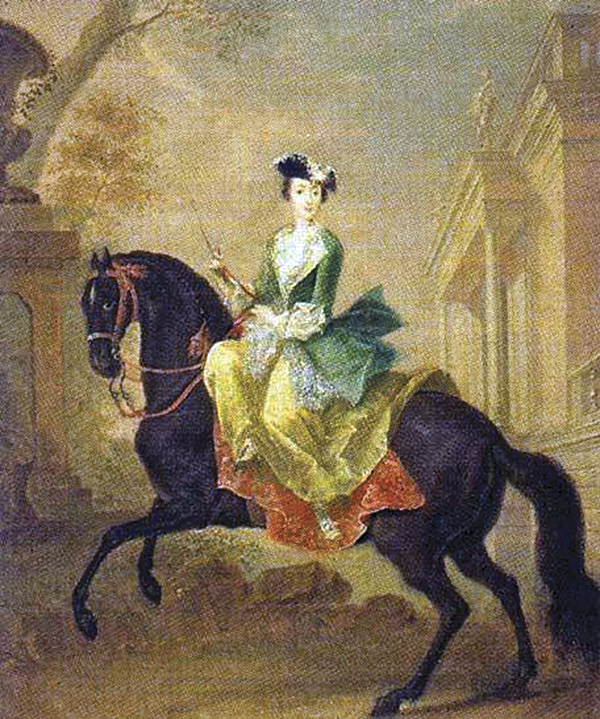
Portrait of Catherine the Great (1729 – 1796), as a young woman, riding sidesaddle. She also rode astride. Photo: Wikimedia
In the 1820s, the balance strap was introduced to make the saddle more stable and secure, and prevent the horse from getting a sore back. It attached to the offside rear of the saddle and was secured to the girth. Today it is a long billet hanging from the offside of the saddle near the cantle, and attaches to the girth. The rear cinch of a Western sidesaddle does the same stabilizing job.
Over time, various changes and adjustments were made. In the 1830s, a third pommel known as the leaping head was introduced. It was positioned on the left side but lower than the fixed head, and believed to be devised by Frenchman Jules Pellier. The leaping head was molded downward in the opposite direction of the fixed head, and curved over the rider’s left thigh. It provided much greater security of movement, including enough to ride at a gallop and over fences. Hunting and jumping now became options while still conforming to the expectations of modesty. By the mid-1800s, the three-pommel sidesaddle was fashionable everywhere, and it even included an offside pocket for the lady’s handkerchief.
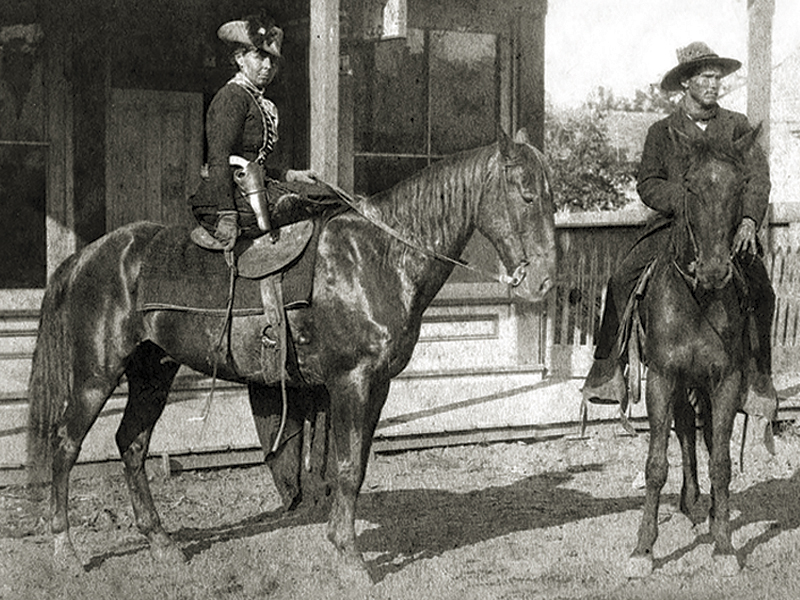
The notorious Belle Starr, “Queen of the Oklahoma Outlaws,” riding sidesaddle. Beside her is Deputy US Marshal Benjamin Tyner Hughes who, along with Deputy US Marshal Charles Barnhill, arrested her and brought her to Ft. Smith for arraignment in May of 1886.
During the latter half of the 1800s, the offside pommel gradually disappeared, leaving the fixed head and the leaping head. The concave seat with a raised cantle was modified to become the more modern level seat of the 20th century. Sidesaddles made today continue to have slight adjustments to properly fit contemporary horses that are no doubt better conformed than those of a century ago.

Western-styled Antique “catalogue” sidesaddle (circa late 1800s), refurbished. Top views show detail of both upright pommel and leaping horn (Images 1, 2). Off (right) side shows the stabilizing girth (Image 3). Photos: Wikimedia/Montanabw
A Sidesaddle Renaissance
Sidesaddle riding is a discipline that has never really gone away, but in the early decades of the 20th century it faded into the background. However, since the late 1990s and early 2000s, it has been making a resurgence worldwide. The hugely popular Downton Abbey television series that depicts the lives of the aristocratic Crawley family between 1912 and 1926 launched a whole new wave of popularity, and curiosity for riding sidesaddle.
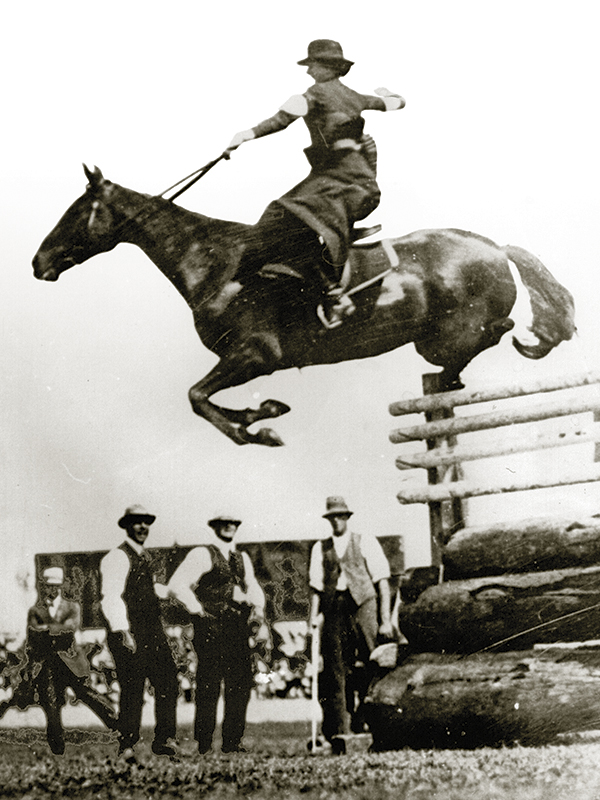
Mrs. Esther Stace, from Yarrowitch, riding sidesaddle and clearing a record 6'6" at the Sydney Royal Show in Australia, in 1915. Photo: Walcha Historical Society
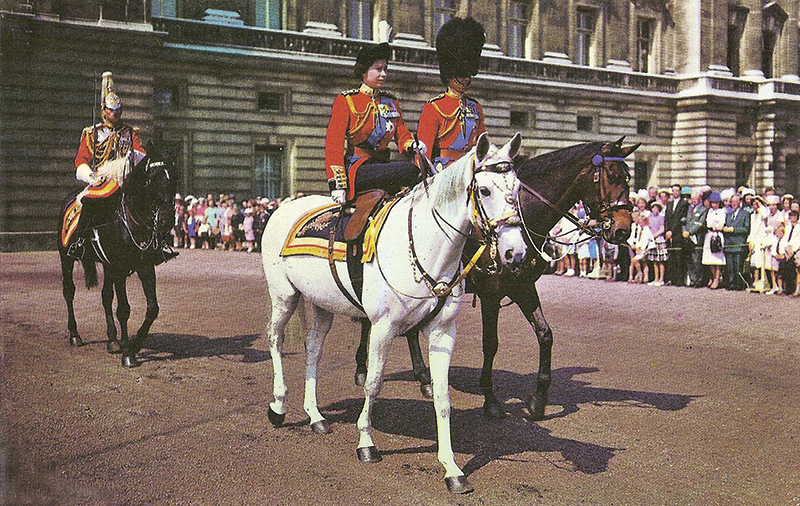
HM Queen Elizabeth II at the Trooping the Colour ceremony, riding sidesaddle on a horse called “Doctor.” Photo: Flickr/Leonard Bentley
“It has been maintaining a steady increase since the creation of The Side Saddle Association (SSA) [Leicester, UK] in 1974,” says Jane Pryor, president. “But Downton Abbey has also attracted new people along with the many costume classes, which have become so popular at the shows with some glorious and extravagant examples of bygone eras and historical riders. Myself, I started at the age of ten so I could go hunting on a bigger pony (in maturity I am only five feet tall), and when the SSA (then the Ladies Side Saddle Association) was formed, I was asked to help quite a few people as I already rode sidesaddle.”
Pryor says that the SSA has a system of grading examinations for instructors, who must also pass the grade tests of riding ability in order to teach to the same level. Overseas riders and instructors also take the exams, either by travelling to the UK or organizing a large enough group to pay for the expenses of bringing a UK instructor to their location. While there is a learning curve, Pryor says that riders generally adapt very quickly.
“Riders usually adjust very well, progress is made quickly, and a confident rider would usually be expected to walk, trot, and canter during their first lesson.”
Maggie Herlensky, president of the American Sidesaddle Association agrees with the Downton Abbey effect. But to that she adds the impact of social media. Before the resurgence of sidesaddle popularity, which she saw beginning in the 1980s, riders basically learned from reading books and using saddles they found stashed away in their own barns. It was trial, error, and persistence. Herlensky got her first sidesaddle in 1983 when she was about 16. “[Today] the American Sidesaddle Association (ASA) has 18 regional clubs in 16 states,” she says.
The appeal of sidesaddle riding has been strengthened in Canada through social media.
“In Ontario, we have a small group known as the Ontario Side Saddle Association,” says Lois Beecraft, secretary, who lives near Guelph and Kitchener. “The aim of the group is to promote and educate about sidesaddle through clinics, demonstrations, and contact on social media. I think active interest in sidesaddle riding is due, in large part, to the accessibility of information and communication through the internet and social media. Distance and time availability make it difficult for people to come together and actually participate in the sport. Due to the COVID-19 situation, our group has been fairly quiet [this year] in terms of clinics.”
Herlensky says the ASA has a list of qualified instructors at all levels. Nearly every regional club has at least one instructor. Like Pryor, Herlensky says that when she teaches a clinic, most students walk, trot, canter, and jump by the end of the day.
Riding Aside
Riding with the right leg bent up and over the withers will feel strange at first. Herlensky recommends that a good stretch before riding, and taking breaks to stretch the right leg frequently, might be sufficient to acclimatize the leg to the new position.
“You use a fairly unique set of muscles for riding sidesaddle, so most people find that that they can be pretty sore after their first few sessions, even those who ride astride a great deal,” says competitor Susan Oakes who lives in Meath, Ireland. “Anything that makes you a stronger rider astride, such as Pilates, makes you a better rider aside, but the best place to get fit is in the saddle. Every pupil is different, but there are some issues most riders tend to have when making the change to aside. They try to carry their hands where they would have them astride and need help to transition to the quite different hand positioning to ride sidesaddle.”
Astride riders are used to trying to stay straight in the saddle, keeping shoulders square with hips and knees. When riding sidesaddle there is a degree of twist in the upper body, and obviously the knees are no longer square with the shoulders. But from behind, the profile of an aside rider and an astride rider should look the same.
“Often when starting out, particularly if the rider feels unstable, they will instinctively try to centre their shoulders over their knees and twist left, which actually makes them even more unstable,” says Oakes. “The phrase ‘right shoulder back’ is one you will hear repeated often in sidesaddle lessons as the rider learns a whole new concept of ‘straight.’”
Oakes does not think a horse needs any specific training to carry a sidesaddle. All the attributes a horse needs to be a well-mannered responsive horse when ridden astride apply directly to sidesaddle. The horse needs to be physically mature enough in its frame to accommodate the extra weight of the saddle and carrying the rider’s weight a little further back. She says that horses with flat, straight movement are preferable for carrying a sidesaddle, as those that are bouncy or choppy are extremely tiring to ride. Very strong pullers and horses that rear are not recommended.
“The balance strap is generally a new experience for most horses, so we recommend lungeing for a few minutes to the right to get used to it,” says Herlensky. “At first, the rider will replace the right leg with a stiff whip or cane, gradually teaching the horse to move from seat aids. The horse can feel a fly land — if he doesn’t react to your seat aid, he’s ignoring you.”
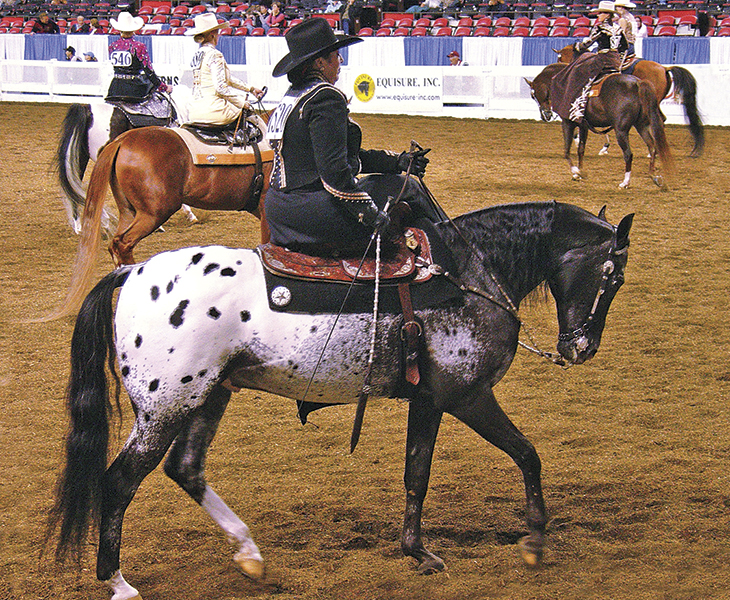
Sidesaddle riders compete in many disciplines, from dressage to Western pleasure to three-day eventing. Pictured is a Half Arabian Ladies Western Sidesaddle class.Photo: Wikimedia/Heather Moreton
The specific skills the rider needs to ride sidesaddle correctly are similar in many ways to those for riding astride. Pryor highly recommends getting instruction from a qualified instructor in order to know how to achieve and maintain the correct position, weight distribution, length and use of the stirrup, use of the aids and the way in which the cane replaces the right leg. Correct positioning will minimize the aches and pains that can come with sitting and trying to ride incorrectly. As for the horse, many adapt well to being ridden with a sidesaddle.
“I have actually never had a problem with any horse changing over to sidesaddle,” says Susan Bellinger who owns Sunset Farm in Shepherd, Michigan, and rides Level II hunt seat and dressage. “Any horse that has been trained off the rider’s seat seems to accept this. But you do want a horse that is trained, rather than a green horse. They might feel a little weird at first with the Sefton girth and no leg on one side. But they should be able to accept the whip [or cane] used on the side without a leg.”
The Sefton girth not only provides the essential function of a girth, but also buckles the balance strap on the offside.
Bellinger’s introduction to riding sidesaddle was quite by chance.
“I went with a friend years ago to watch her take a sidesaddle lesson,” she says. “Luckily, her instructor asked if I would like to try it too. That was it — I was hooked!”
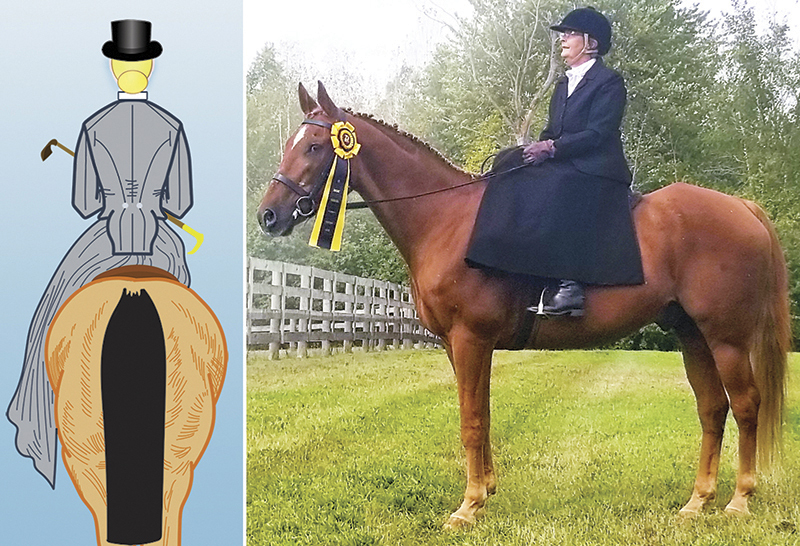
Susan Bellinger stresses the importance of posture and keeping the right shoulder back. She says that sitting from the head and shoulders to the hips should be the same when riding sidesaddle as when riding astride. Photo: Susan Bellinger
She says that riders new to sidesaddle can feel comfortable if the saddle fits both them and the horse properly. But if they struggle with their position because of a bad saddle fit, it will not be enjoyable. While she does not feel that cross-training is essential, she definitely encourages riders to develop core strength, and recommends that new riders take the transition to sidesaddle slowly, and not ride for long periods of a time at first.
“Posture is important,” says Bellinger. “Keep that right shoulder back. Sitting from the head and shoulders to the hips should be the same as if you were astride. It’s important to realize that a lot of the weight is in the thigh as it crosses over the horse’s spine. The saddle must fit the rider and the fixed head must be the correct width for the rider’s thigh.”
One interesting and often overlooked fact is that sidesaddle riding can be more appealing than riding astride for riders with disabilities. Those with certain kinds of challenges often find the sidesaddle’s design to be more comfortable and provide extra security. And the discipline has a unique and compelling appeal.
“I taught a lady who had been born without a ball-and-socket joint in one hip, just a flat joint, and she could not ride a horse astride,” says Pryor. “She learned to ride sidesaddle from scratch, had to learn all the aids and how to control a horse (which the established astride rider can already do), and was able to jump a small jump during her 20th lesson. All her lessons were on riding school horses as she did not own a horse. She was able to ride at all paces and eventually got her own horse.”
Beecraft agrees that sidesaddle riding has many therapeutic values for those who have difficulty riding astride. Sometimes, getting started can come from the most traditional experiences. As a child, Beecraft was drawn to the discipline as a child by a picture in the classic book, Black Beauty.
“I bought and rode in my first sidesaddle in 1974,” she says. “The initial motivation to find the saddle was from my involvement in a program for special needs riding. We had a rider whose physical condition would not allow her to sit astride, and finding a sidesaddle allowed her to still learn to ride.”
Patricia Hardy, who owns Belvoir Hill Farm and Riding Centre in Omemee, Ontario, got her start sidesaddle riding when her father found a sidesaddle and bought it for her. Soon she was competing in horse shows and country fairs, since many offered sidesaddle classes. Like Bellinger, she stresses the importance of strength in the right leg.
“There is a tremendous learning curve — not that there is much to learn (provided you are a capable rider already) — but the things you do learn are very important and specific,” she says. “You have to get very strong in your right leg to keep it bent over the fixed head of the saddle. You have to keep it pressed into the horse’s neck/shoulder to keep yourself on. This is referred to as your ‘purchase’ [strong grip]. It [can] put strain on your hip. You should ride just 15 minutes a day to get in shape. This applies to the horse as well. You also have to keep your right shoulder back under all conditions or you will corkscrew off the horse at a canter.”

Patricia Hardy, who has been riding and competing sidesaddle since she was a child, in show attire. Photos courtesy of Patricia Hardy
Beginner riders always learn to canter to the right, since cantering to the left has the potential to spin the rider to the left, possibly twisting them off if they fail to keep the right shoulder back. Going left means only the head can turn left, not the shoulder. The trick is not to over-twist or over-compensate. Riders must also get used to sitting about 15 centimetres (six inches) behind where you would sit astride. Frequent hacking or recreational riding can help both the rider and the horse get used to these adjustments.
“A horse should be at least four years old with a reasonable degree of schooling and manners,” says Pryor. “Most horses take to sidesaddle very well, but it is essential to get expert advice on the fitting of the sidesaddle to the individual horse, and it is also important to make sure the saddle is suitable for the size of the rider. There are several racehorses that have made the transition from the track to the show ring with great success, and many different breeds can be seen performing well. A well-mannered horse is ideal for both horse and rider to learn together, and this is also gratifying for the owner/rider to progress through the ranks.”
While some shows have sidesaddle classes, many breed organizations allow sidesaddle in open classes.
“Most of us are used to showing primarily against astride riders,” says Herlensky. “Our members compete in many disciplines, from dressage and Western pleasure to saddle seat, hunt seat, and even three-day events. I was an endurance rider for many years, completing about 3,000 miles (over 4,800 km) aside.”
Oakes has been riding sidesaddle almost all her life, garnering some major accomplishments along the way.
“Horse riding is in my blood,” says Oakes. “I was born into an equestrian family and I was basically born on a horse. My ancestors on both sides of my family rode sidesaddle so, by the age of four, I was riding my donkey, Rosie, in one of my grandaunt’s sidesaddles. I have a few achievements to date. I have been lucky enough to compete and ride sidesaddle all over the world. The highlights were jumping the puissance wall at six feet eight inches, and the triple bar at six feet five inches, winning the inaugural running of the Diana’s of the Chase [a sidesaddle steeplechase in England], and riding in sidesaddle races in Ireland, United Kingdom, France, United States, and Canada. It was a privilege to take part in the Calgary Stampede.”
Finding a Saddle
The big stumbling block for many riders wanting to try sidesaddle riding is acquiring the saddle.
“Back in the day, the top and best saddle makers were Whippy & Stegall, Owen & Co., Mayhew, and Champion & Wilton,” says Hardy. “They were all located on Oxford Street, London, UK. Every saddle was measured and made for a specific horse and rider, and it took many fittings for the actual saddle to be made. I bought three saddles before I found the one that I wanted, a Whippy & Stegall. Some of the very old Victorian or antique sidesaddles are not very comfortable. The leaping head and fixed head are too narrow, and this makes it very uncomfortable for riding for long periods.”
As much as the old saddles are largely inappropriate for today’s horse and rider, some saddles can be restored to use.
“Our English sidesaddles are primarily built in England, but prior to 1940s,” says Herlensky. “One American company is building really nice quality Western sidesaddles. I helped Crest Ridge Saddlery on the design of their tree and they now have two Western models and the Crossover, which has an English look on a Western tree. Steele used to make a line of sidesaddles but has ceased production. There are a few hundred still out there, though that are really nice saddles that have held their value.”
But with the escalating popularity of sidesaddle riding, a number of saddlers in England are building new designs.
Rob Jenkins, who owns Malvern Saddle Co. Ltd., in Worcester, UK, trained as a general saddler in Walsall, England, in the early 1990s. He became a Master Saddler in 1995 and began learning about sidesaddles in 1996. Like many others, he has seen a remarkable resurgence in sidesaddle riding.
When asked if he has seen renewed interest in sidesaddle riding, Jenkins replies: “Most definitely! So much so that I no longer work on or restore the old saddles, as so many riders are looking for more modern saddles to fit the generally broader and shorter-backed horses that we have nowadays. There is also a real safety concern with the older saddles as most are 100-plus years old.”
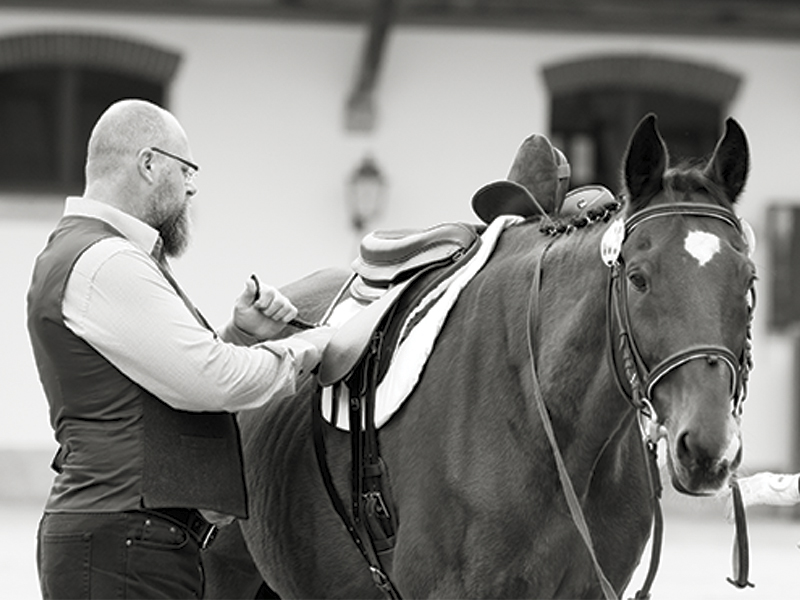
Master Saddler Rob Jenkins of Malvern Saddle Co. Ltd. Has seen a resurgence of interest in sidesaddle riding. He no longer restores old saddles due to rider demand for safer, modern saddles to fit today’s horses.
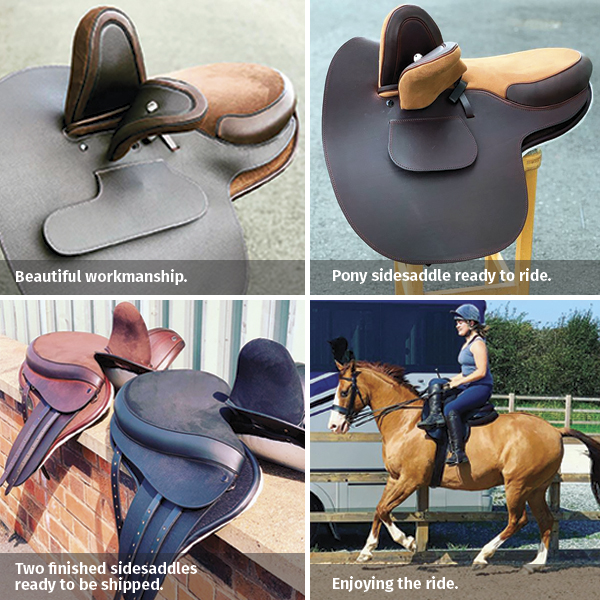
Photos courtesy of Rob Jenkins
Making sidesaddles today is definitely a blend of traditional and new skills.
“Most of the skills are the same as for making an astride saddle, but the difference is that sidesaddles are asymmetric and astride saddles are designed to be symmetric,” Jenkins says. “It can be a challenge to think in a different way. The panels are also very different. I have developed a hybrid panel, which works like a close contact felt panel, but can be adjusted with wool flock and felt shims. They are very stable and require less adjustment once setup correctly.”
He does say, though, that some horse breeds present more problems than others. “The most challenging breeds are Arabians and some native breeds such as Dales and Fell ponies. There is normally a solution to be found, but sometimes you have to admit defeat.”
While Jenkins is able to make templates for sidesaddle construction, he much prefers to fit each saddle in person to ensure a good fit on the horse, and make sure the client is happy with their purchase.
“Sidesaddles have a tricky role to play, as the rider is required to balance the saddle with her seat and position, as well as the horse having to carry an uneven load, which makes fitting adjustments essential.”
Sidesaddle riding is not confined to adult ladies. Children also ride aside and, surprisingly, some men.
“There are many children who ride and compete sidesaddle, enjoying all aspects of horsemanship,” says Pryor. “Sidesaddle riding is not confined to girls, and several boys (and gentlemen) ride sidesaddle very happily and with success hunting, cross-country, and in the show ring. Riders enjoy using their sidesaddles in a great variety of ways — some simply recreational or for disability reasons — but we have a strong contingency of riders in the show ring, hunting (which has gained enormous popularity with organized sidesaddle meets and arranged ‘party trips’ to Ireland), and jumping events are no problem!”
With children riding sidesaddle, Jenkins has developed tack specifically for their needs.
“For very young children, I offer something known as a Pilch Pad, which is a starter saddle for youngsters to learn on,” he says. “The pommels are reversable, which means it can be ridden to the near side or off side. For older children and very small adults, I am developing a new tree, which will fill the gap between the Pilch and a full-size sidesaddle, but this is a slow process and so far I have only made a few prototype models.”
Pryor says that the Society of Master Saddlers has done much to encourage and maintain the skills and workmanship involved with restoration, rebuilding of saddles, and new saddles.
“They also hold an annual sidesaddle-making competition, which has produced many excellent saddles for judging,” she says.
Attire
Along with the need for a properly fitting saddle is appropriate attire. Gone are the dangerous long gowns (except in specific show classes). Today’s sidesaddle rider wears a riding habit consisting of a shirt, jacket, stock, top hat and face veil, and an apron worn over riding breeches and boots. The apron is wrapped around and buttoned up once the rider is mounted. The Side Saddle Association has a link on its website for those selling habits or aprons. However, riders with sewing skills are able to put those talents to good use and access patterns produced for equestrian clothing.
“Habits, aprons, and such are getting easier to find as many of us who sew are sewing for others,” says Herlensky. “There are a couple of companies in England that also make habits. For beginners, we recommend wearing what you already have, and add an apron. Patterns are available and most of us know how to sew at least well enough to get started. And now that sidesaddle is gaining in popularity, and some of us are just ‘gaining’ (thanks to COVID-19!), used habits are getting easier to find.”
It is a little more difficult to purchase sidesaddle attire in North America, depending on the style, but sewing skills have value.
“I have made some of my own sidesaddle outfits and have purchased others,” says Beecraft. “Renting outfits may also be a more feasible option.”
Competition rules can be pretty exact. For a sidesaddle hunter class in the US for example, USEF states the gold tie pin must sit horizontally, not vertical, coat buttons must be black bone, and competitors must carry a sandwich case and flask. The sandwich must be wrapped, and the flask must contain sherry or tea.
Interest is Growing
As more riders get mounted, those skilled in sidesaddle are coaching and encouraging beginners.
“Around the world there are many excellent coaches,” says Oakes. “I have just collaborated with Joe O’Reilly Equestrian tours, where we will welcome ladies of all levels of sidesaddle riding to participate in weekend and weekly sidesaddle training packages. The theme will be ‘The Empress Way’ in honour of The Empress of Austria, who was an amazing sidesaddle rider and came to Ireland to hunt back in the late 1800s. Amazingly, she hunted with the Meath Foxhounds across my family farm, and the jump she jumped on the farm was called the Empress Gap. It is still there today. My goal going forward is to showcase sidesaddle riding as best I can. For 2021 I have organized sidesaddle safaris. I also hope to hunt with all packs in the US and Canada in 2021-2022. That will be a mammoth task.”
Some 640 years ago, Anne of Bohemia rode sidesaddle to England to marry King Richard. For an arranged marriage, it was a stunning success. The teenagers fell in love and were inseparable. With her kindness and her reputation to intercede on behalf of the people, and seek numerous pardons for supposed wrongdoers, she became very popular. Tragically, she died in 1394 at age 28, likely from the plague.
According to historians, Good Queen Anne brought to England a dignified and modest way of riding aside. Today, the ancient discipline of riding sidesaddle has swept worldwide. She would be truly proud.
For more information, visit:
- www.sidesaddleassociation.co.uk
- www.malvernsaddlecompany.co.uk
- American Sidesaddle Association can be found on Facebook.
Additional Historical Photos
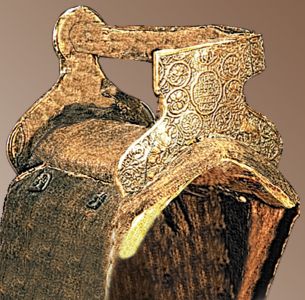
Sidesaddle from Iceland, circa 1682. Photo: Wikimedia

Swedish sidesaddle (date unknown) of red cloth with cover of natural-coloured linen and remnants of gold sheer. Rounded corners are edged with woven ribbons, with the cover hanging loosely. The seat is upholstered, with two horns 280mm (11 inches), and 175mm (6.9 inches) high. In front of these is a rectangular upholstered cushion lined with gold gallon. On the off (right) side is a large rectangular covered brace (handle). The lining is fabric, with six saddle straps, two leather stirrup straps, and a leather loop for tail cap. A saddle belt accessory is approximately 1100mm (43 inches) long of blue and yellow striped fabric.
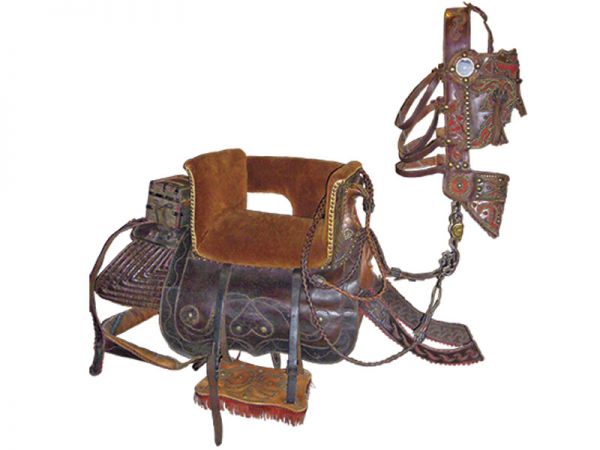
Catalan bridal saddle with “planchette” or footrest, with matching bridle, from Wedding ceremonies in Spain collection, Muleteer’s Museum located in Igualada, Catalonia. Photo: Wikimedia/Jordiferrer
Main Photo: “On an errand of charity — Christmas morning.” From a painting by J. Charlton, 1880. Credit: iStock/Duncan 1890




